The Ultimate Guide to Note-Taking
No matter what your profession, there are lots of reasons to take notes. You take notes to retain information from things you hear - like meetings and presentations. You take notes to capture facts or ideas (e.g., interviews, itineraries, something said in passing, etc.). You take notes to problem solve or brainstorm. You take notes to visualize complex systems or concepts.
You probably already have a preferred method of taking notes. This might be a specific method you learned in school, or it might be the "jot-down everything on whatever is in front of me" method. However, different types of information demand different styles of note-taking. What works for outlining a blog post might not work so great for brainstorming new ideas.
It's also important to recognize how you process information. Are you an analytical learner or a visual learner? Do you like inserting notes into a structure of rows and columns, or do you prefer to use a blank page to draw your ideas?
Finally, the growth of digital note-taking platforms means that you never have to use a pen and paper again (only sort of joking). Personally, I love taking notes the old-fashioned way. I like the freedom to be able to use the whole page without working within the constraints of the traditional paragraph style. However, I will admit to using cloud-based apps like Evernote to annotate websites I'd like to revisit or to snap photos of presentation slides I'd like to review from home.
Whatever your preference, I've created this post to share every note-taking style I could find. I originally did this for my own benefit - so I could tailor my note-taking style to fit any situation. I hope you find it useful and maybe it will give you a couple of new ideas for your note-taking options.
Oh and if you need a place to take notes, check out my Spark Notebook. Most of the pictures in this post were created using layouts from that notebook. :)
ANALYTICAL LEARNERS
Outline/List
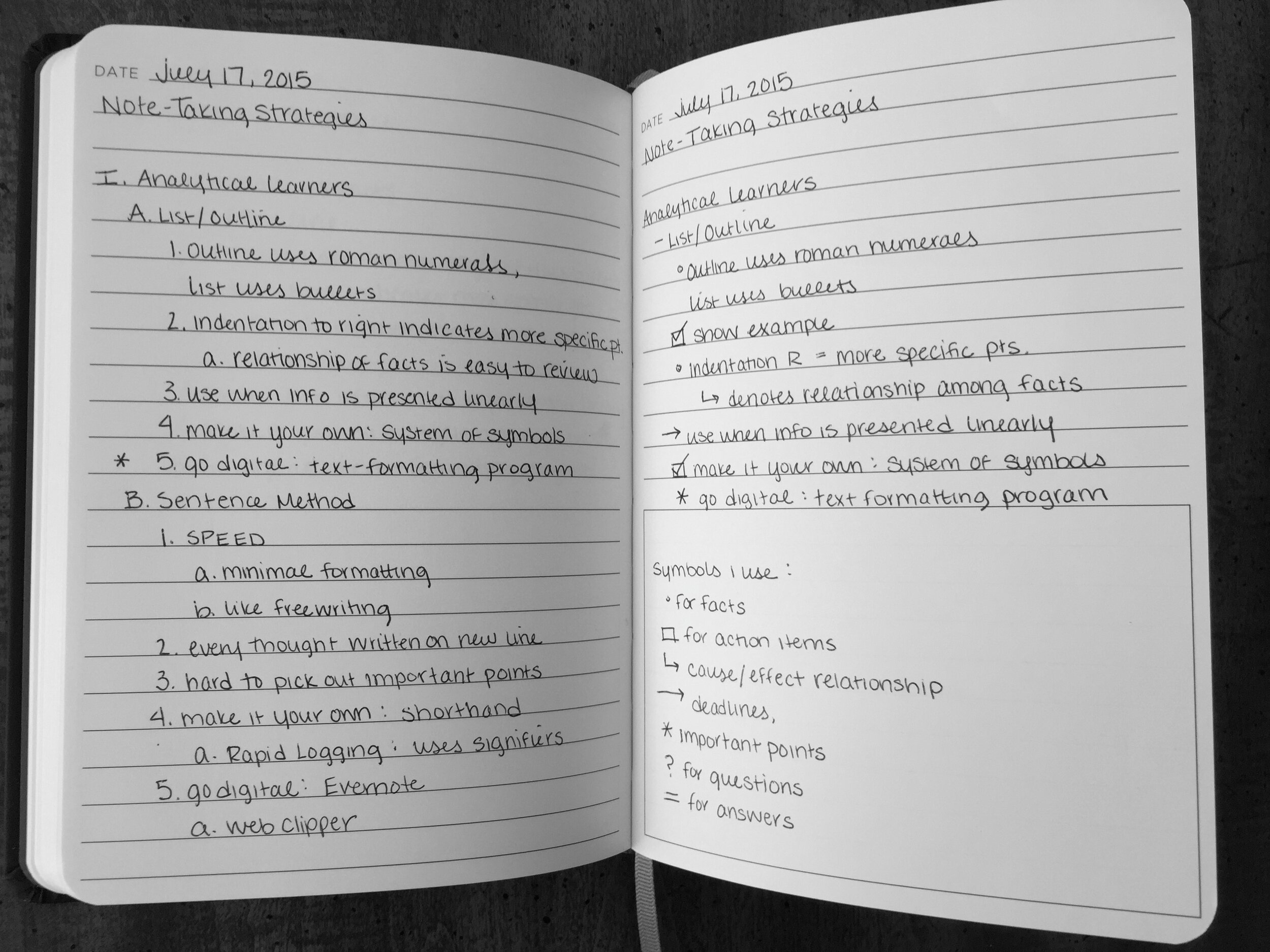
[notes from this post]
The Outline/List is probably how you were taught to take notes in school. It is a linear method of taking notes that proceeds down the page, using indentation or bullets to denote major and minor points.
A typical Outline system would begin with a roman numeral and a key topic. Subtopics would be listed below with qualifying points below that. A system of indentation, Roman Numerals, letters and numbers are used to signpost more detailed points.
A List system is very similar to the Outline system (and we are getting a little bit technical here), except it drops the archaic use of Roman numerals, opting for bullets and sub-bullets. What distinguishes the List and Outline system from others systems is it’s use of space down the page linearly with major points farther to the left while more specific groups of facts are indented to the right.
The great thing about the List/Outline system is that it records content relationship in a way that is easy to review. Information is usually organized (e.g., by chapter, by event, etc.) , and you can easily pick out headings and subtopics from groups of facts. This means it’s a handy tool for outlining essays or blog posts—anything that has a natural structure or sequence.
The benefits are also the drawbacks of this system. The List/Outline requires more complex thought during the note-taking process, so information presented too fast or sporadic can be difficult to record with this system. It can also be difficult to go back and add or edit information written with this system, so it’s best to use this when information is already organized in a similar format.
When to use:
- Works well for recording terms, definitions, facts and sequences
- Use when taking notes on slides or readings
- Is often used in conjunction with another note-taking method
Make it your own:
I use this method AFTER I’ve finished the gathering information stage as a way of organizing my blogs posts. However, I usually “hack” the traditional List system with my own system of symbols. For example, I use dashes for subtopics, bullets for facts, checkboxes for action items and lots of arrows to show direct cause and effect relationships. I also use stars and question marks in the margins to mark lines that I want need to pay attention to later.
Go digital:
If you like the List/Outline method of note-taking, you’ll find that it’s super easy to use in any text-formatting program (like Microsoft Word). In fact, it’s usually easier to take List/Outline notes on a digital device because you have the flexibility to add in lines of text and change the order with some keystrokes.
Sentence Method

[notes from budget meeting]
The Sentence Method is like free writing for notes. The goal is to jot down your thoughts as quickly as possible. Because speed is the focus, format is kept to a minimum: every new thought is written on a new line. That’s it! This means that it is slightly more organized than a dense paragraph, but there is no way to pick out major or minor points from a sequence.
Because this system lacks organization, it can be hard to understand unless you review and edit information following your note-taking.
When to use:
- Works well in meetings or lectures that lack organization
- Use when information is being presented very quickly
- I often use this method as a laundry list of facts or to-do items
Make it your own:
Although it’s called the Sentence Method, there is no reason to write in complete sentences. This would be a waste of time. You can learn how to write in shorthand, or you can create your own shorthand system of abbreviations and symbols that make sense to you.
Here, I've re-written the previous paragraph in my own simple shorthand:
- Sent Meth ≠ full sent b/c waste o time
- learn shrthnd --> make systm of abrv/symb that mk ¢ 2 u
Notice that I drop extra words and vowels while using symbols where possible. Although my shorthand "rules" aren't always pretty or consistent, it makes sense to me, which is what matters.
Another take on the Sentence Method is Rapid Logging. Like the Sentence Method, individual notes are jotted down quickly on separate lines using signifiers like x, < or >. Much like my system of symbols, these signifiers can be quickly scanned to determine the context of each note. The Rapid Logging system also recommends numbering pages for each group of notes, so that notes can be cataloged later. This system works well if you plan to keep all your notes in one book.
Go digital:
For taking quick and dirty notes, consider Evernote, a free cross-platform universal capture app. Notes can be tagged, archived and organized into different notebooks. Images you add to Evernote can be searched just like text. Because it is available on most smartphones and desktops, it's a great place to keep your notes in one place. My favorite feature is the web-clipper browser extension which clips URLs or web articles to one of your notebooks. I'm much more likely to return to a site I've clipped to Evernote with a quick description of why I liked it than I am to search through my bookmarks bar.
SQ3R
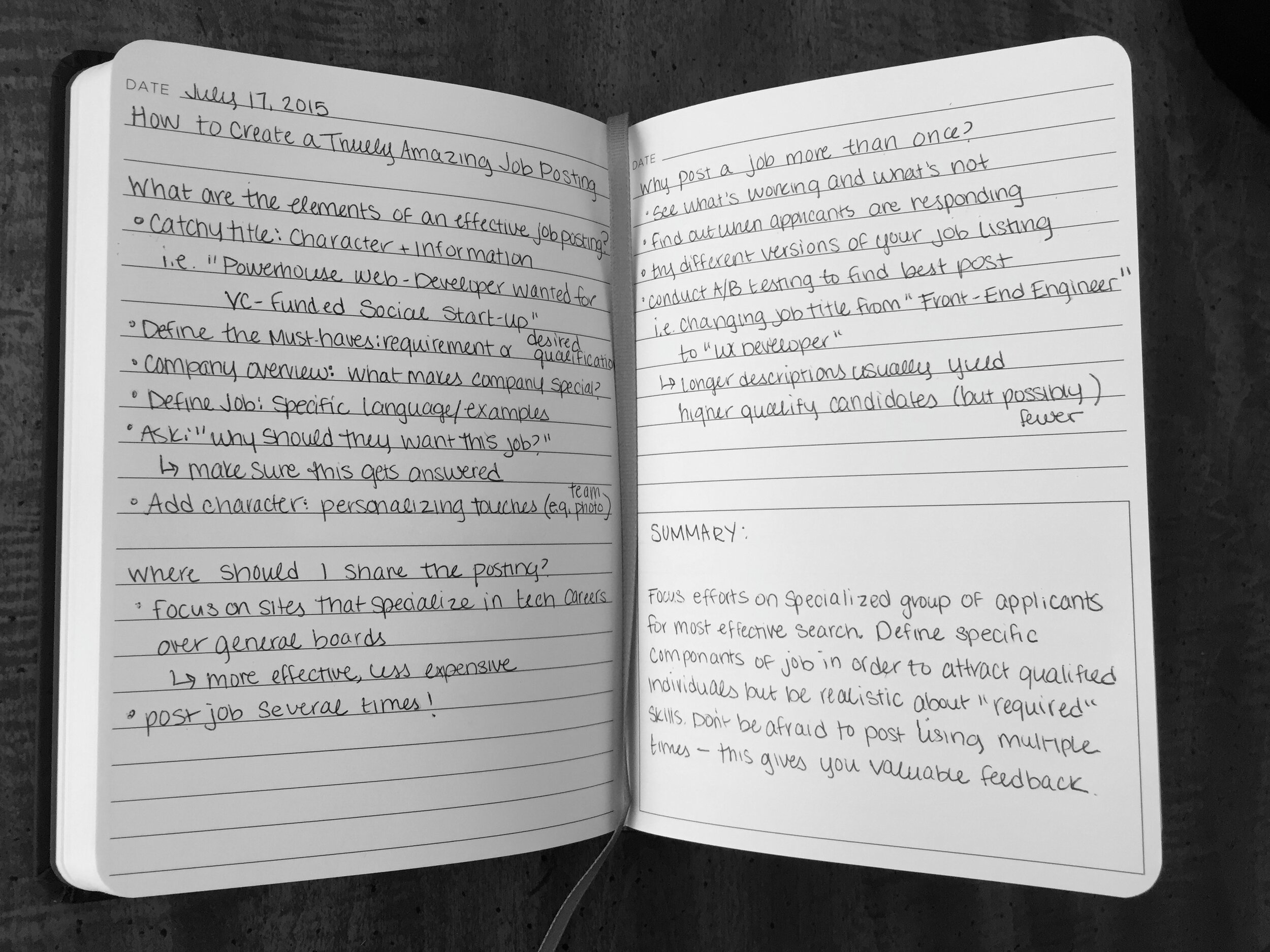
[notes from my Tech Hiring Guide]
SQ3R (Survey, Question, Read, Recite, Review) is a method of note-taking used primarily for written material. You start the process by skimming the material for bolded text, images, diagrams and summaries in order to produce a list of headlines or main topics. Each headline is then written in the form of a question. Note these questions as section headers on the page. As you read the text, consider each question. Record your “answers” to the reading questions under each corresponding header. Once you’ve finished reading the text, write a summary of the material from memory—this is the “recite” part of the process. Finally, review your notes to make sure you’ve completely grasped the concepts.
Reading dense material can sometimes be hard to grasp. This method motivates comprehension by giving you a reason to read. Actively searching the text for answers to your questions will help you better retain the material.
When to use:
- Use for dense readings (like business books, text books, whitepapers, etc.)
Make it your own:
The main purpose of SQ3R is to give purpose to your note-taking. Although this method pertains to reading text, you can use the major idea behind this system to help you actively listen to a presentation or browse the web with purpose.
Ask yourself, what do I hope to gain from this presentation/by searching the web? What questions do I have that I'm hoping to answer? Write those questions down and only take notes that pertain to those questions. If the speaker didn't address these points in the presentation, you usually have time to ask questions afterwards. If you find gaps in your online research, specify your search parameters. This reduces time spent writing and ensures that you leave with exactly what you need know.
Go digital:
If you plan on typing your notes, consider using a text expansion tool to save yourself from writing out commonly used phrases over and over again. Maybe you're taking notes on a text about finance and you frequently come across the phrase "fixed versus variable costs." Instead of typing this every time, you simply type a predefined shortcut like f/v and the text expander automatically replaces the shortened phrase with the one you want.
VISUAL
Mapping
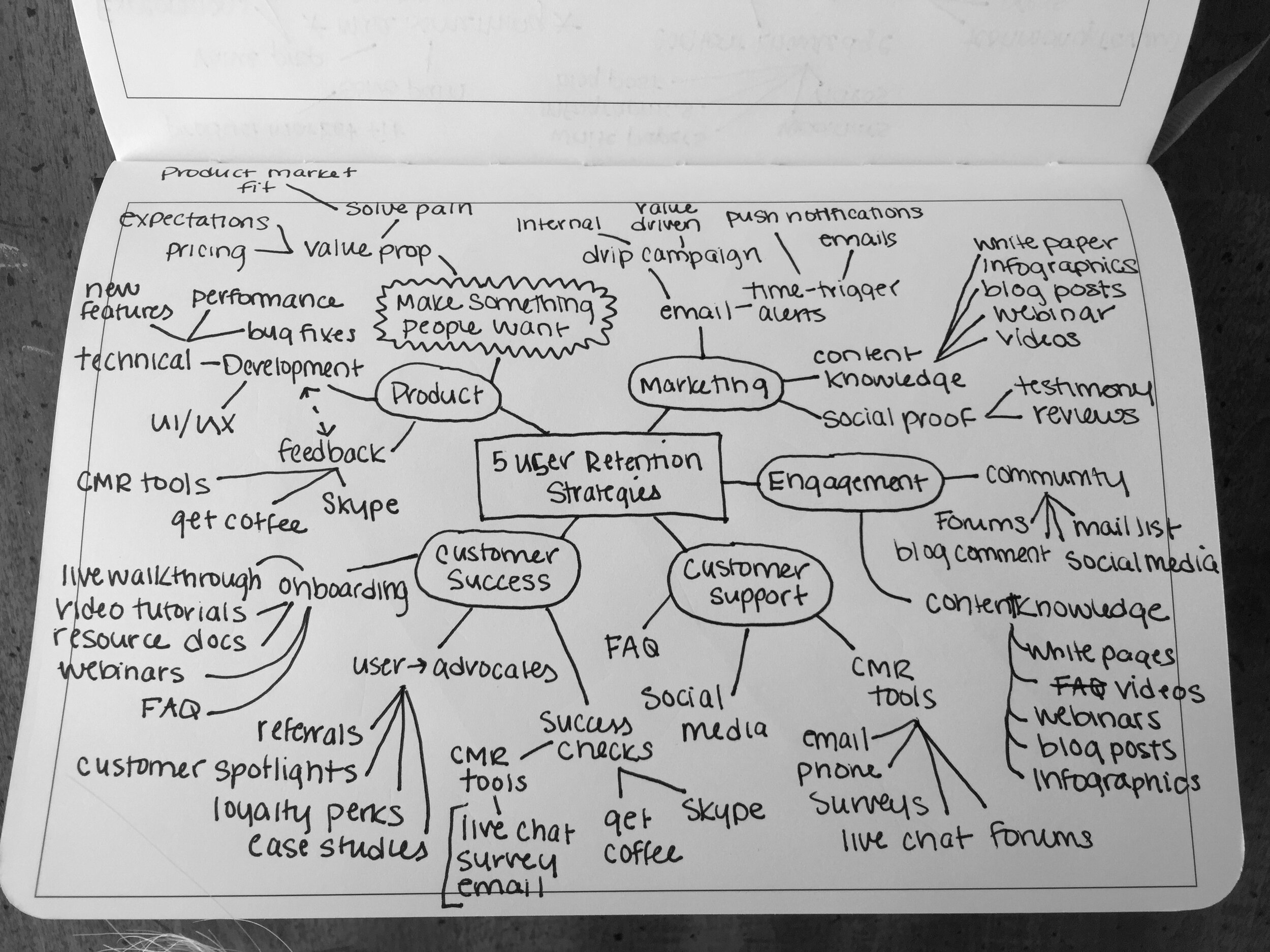
[notes from blog.framed.io]
Mapping is a nonlinear system of note-taking that resembles a tree and root structure. Ideas stem from one major concept and are connected by lines (or “branches”). As a note-taking system, mapping works particularly well for visual learners, but it can also be a great tool for analytical-thinkers who have trouble brainstorming because it allows you to make connections you’d otherwise miss with a linear format.
To start, write down the main topic, essay headline or meeting name at the center of the page. Draw lines from the original topic to create subtopics that represent different ideas. Subtopics can also branch out into separate threads to illustrate a more detailed concept. Each note represents a different idea. A line or arrow connecting two facts or ideas represents a relationship.
This method maximizes active participation, immediate understanding and emphasizes critical thinking. Instead of copying material verbatim, you process information in a way that relates every idea to every other idea. In fact, a study published in the British Journal of Educational Technology revealed that nonlinear note-takers performed 20% better than linear note-takers when measuring comprehension.
That is not to say that this method works for everybody under every circumstance. A drawback of mapping is that it can be time consuming. Your brain must process the fact or idea and its relationship to the broader concept, so mapping is not always appropriate when you need to recorded dense or detailed notes. When maps get too complex, it can be hard to distinguish the main concept from supporting facts.
When to use:
- Works well for planning essays, recording meetings
- Use for big-picture brainstorming sessions
- Is extremely customizable and easy to edit/add to later
Make it your own:
Mapping can be used very effectively for meeting agendas. This is particularly true if there are multiple speakers and the meeting ideas jump around. As speakers present ideas at the meeting, draw a line from the sub-agenda items to write the main idea. Try using a system of symbols like bubbles or stars to emphasize the important points. This system also allows you to keep track of who says what. Simply connect the speaker’s name to his or her idea to give credit where credit is due. If someone brings up an unrelated topic, make it a floating sub-topic by drawing a box around it in an unused corner of the page. This strategy can also be used to document your own thoughts in a meeting.
I am most likely to use mapping when I’m feeling blocked. It helps me get ideas on paper without worrying too much about order. As my map grows, I connect ideas and facts to develop a sense of direction. Then, I’ll rewrite my notes in a more classic outline format so that it’s easier to make sense of when I sit down to do the actual writing.
But my maps rarely resemble the traditional tree-structure. Instead, they look more like what Scott Young describes as “flow-based notes”. Flow-based notes are a hybrid of different note-taking styles. Based on the mapping system, flow-based note-taking uses diagrams, doodles and bullets to explore information holistically. It’s not always pretty, but this method helps me capture ideas floating around in my head.
Go digital:
Digital mapping has come a long way in the last couple of years. Although I like the beautiful mess that my maps usually result in, a digital mapping tool can provide more structure to organize your notes. Lifehack users recommend XMind as their go-to software for mapping. XMind works across platforms (Windows/Linuxs/Mac) and with other apps (Evernote, Excel, Powerpoint, etc.). Besides being free, the biggest advantages of XMind (and other digital mapping software) is it's ability to transform your map into an outline. This can save a lot of time if you normally complete this process in two steps.
Smart Wisdom
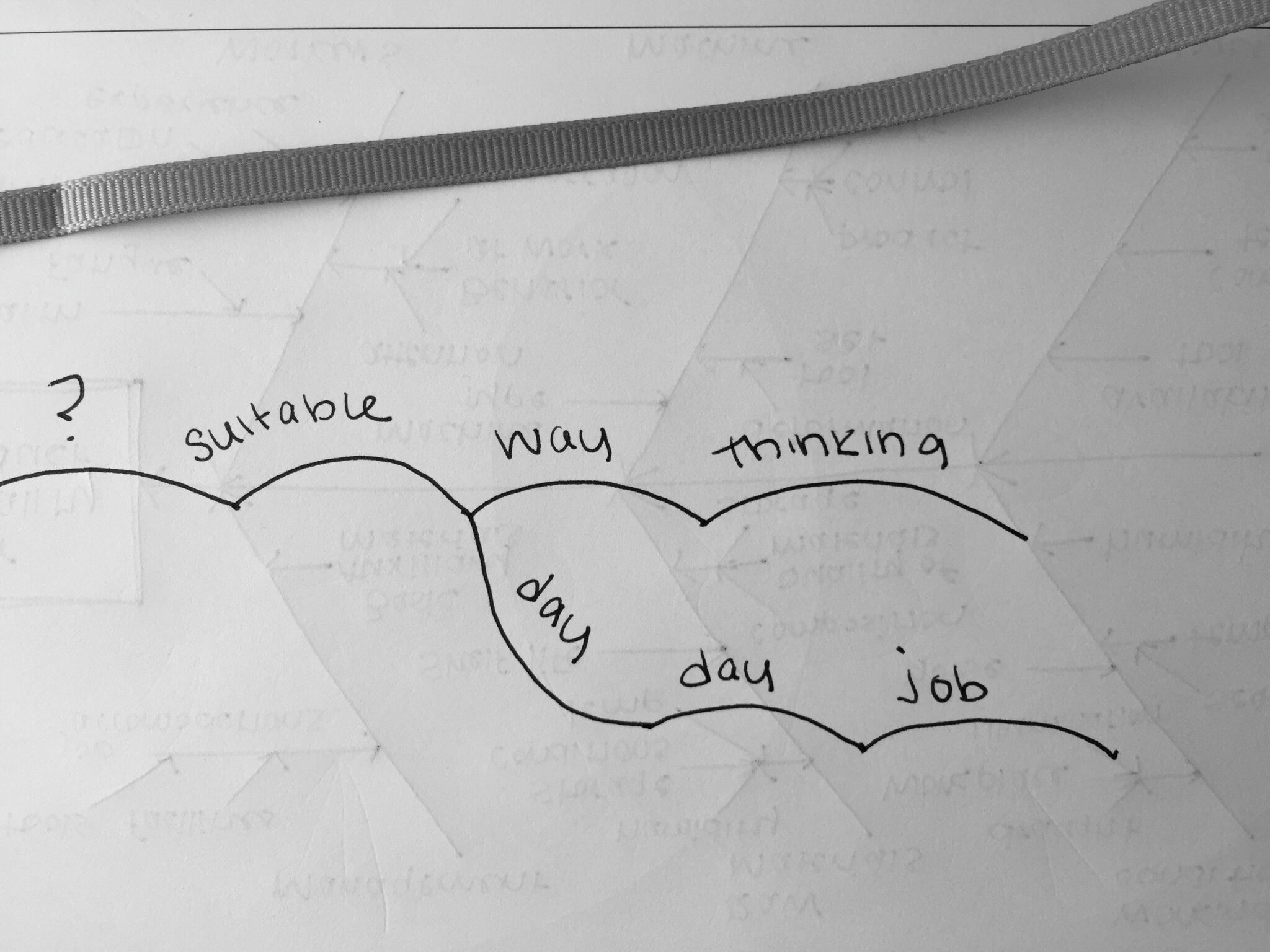
[notes from drewhajduk.co.uk]
Created by Jonathon Kemp, Smart Wisdom is a very specific way to use the mapping system. It’s a tool optimized for active listening in lecture situations. Instead of taking notes in full sentences, you record only keywords and place them in a chain that maps the thought process. This chain is written on a web-like grid, starting in the 1 o’clock position and working clockwise. Unlike the mapping system where main ideas are linked to other ideas, Smart Wisdom links key words in a kind of shorthand.
Here’s an example borrowed from Drew Hajduck:
You want to record the question, “Is it suitable for my way of thinking and my day to day job?”
With Smart Wisdom, you break this phrase into key words:
suitable / way / thinking / day / day / job?
This shorthand allows you to take notes in “real time” so that you aren’t forever playing catch up. There is also some evidence that this system works well for dyslexic learners.
The drawback to this system is its complexity and lack of accessibility. Because there aren’t very many resources for learning how to use Smart Wisdom, the best way is through a course offered directly by Kemp.
When to use:
- Works well for dyslexic learners
- Use in meetings or lectures
Make it your own:
Smart Wisdom is a great example of how one man revamped the mapping system to work in a way that fit his way of thinking. Figure out what works best for you and then share it with this rest of us!
Go digital:
Smart Wisdom offers a number of online and in-house courses as well as digital templates to help get you started.
Diagrams and Processes
Diagrams help visually represent content. However they are not always versatile. A diagram usually serves one purpose best, so selecting the right diagram will make your notes more meaningful.
When to use:
- Depends on the type of diagram (I've listed three below)
- Use to sequence events, compare and contrast or identify cause and effect
Make it your own:
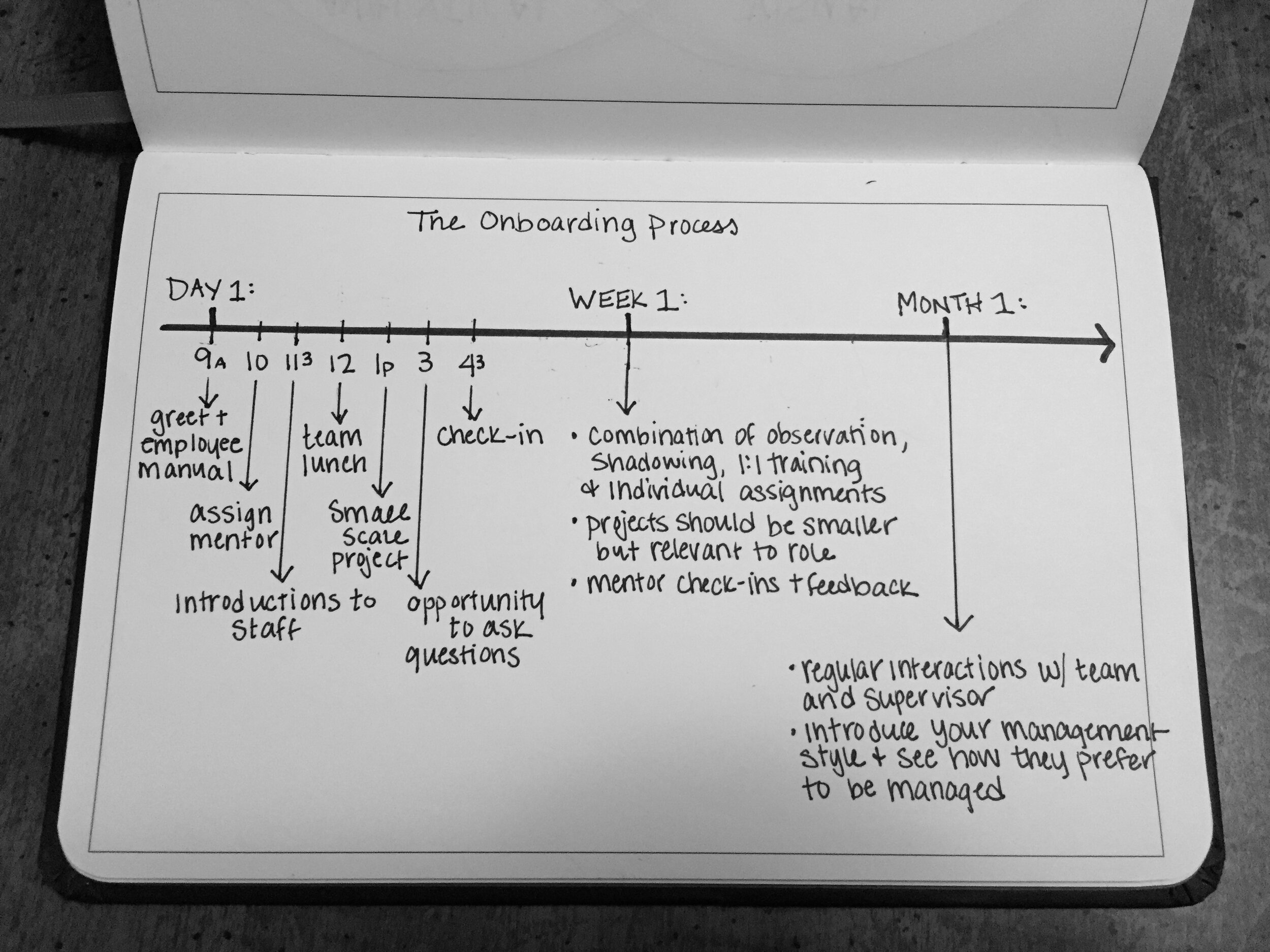
[notes from my Tech Hiring Guide]
Process diagrams – These are typically diagrams that demonstrate a sequence of events. A classic example of a process diagram is a timeline. The timeline represents a continuum of dates and events. However, a timeline need not be limited to two-dimensions. Timelines can be multidimensional (i.e., date, relevant event, another event). Timelines are particularly good for recording history or biography, but they can also be used to compare and contrast similar events. For instance, you could make a timeline detailing the development of web analytics vs. social analytics (see example).
Another type of process diagram is the flow chart. The flow chart is represented by individual steps that start from a problem and lead to a solution. Each step is denoted by a different kind of shape which symbolizes whether the note requires action or decision. Unlike the timeline, a flow chart can veer in multiple directions, leading to different scenarios.
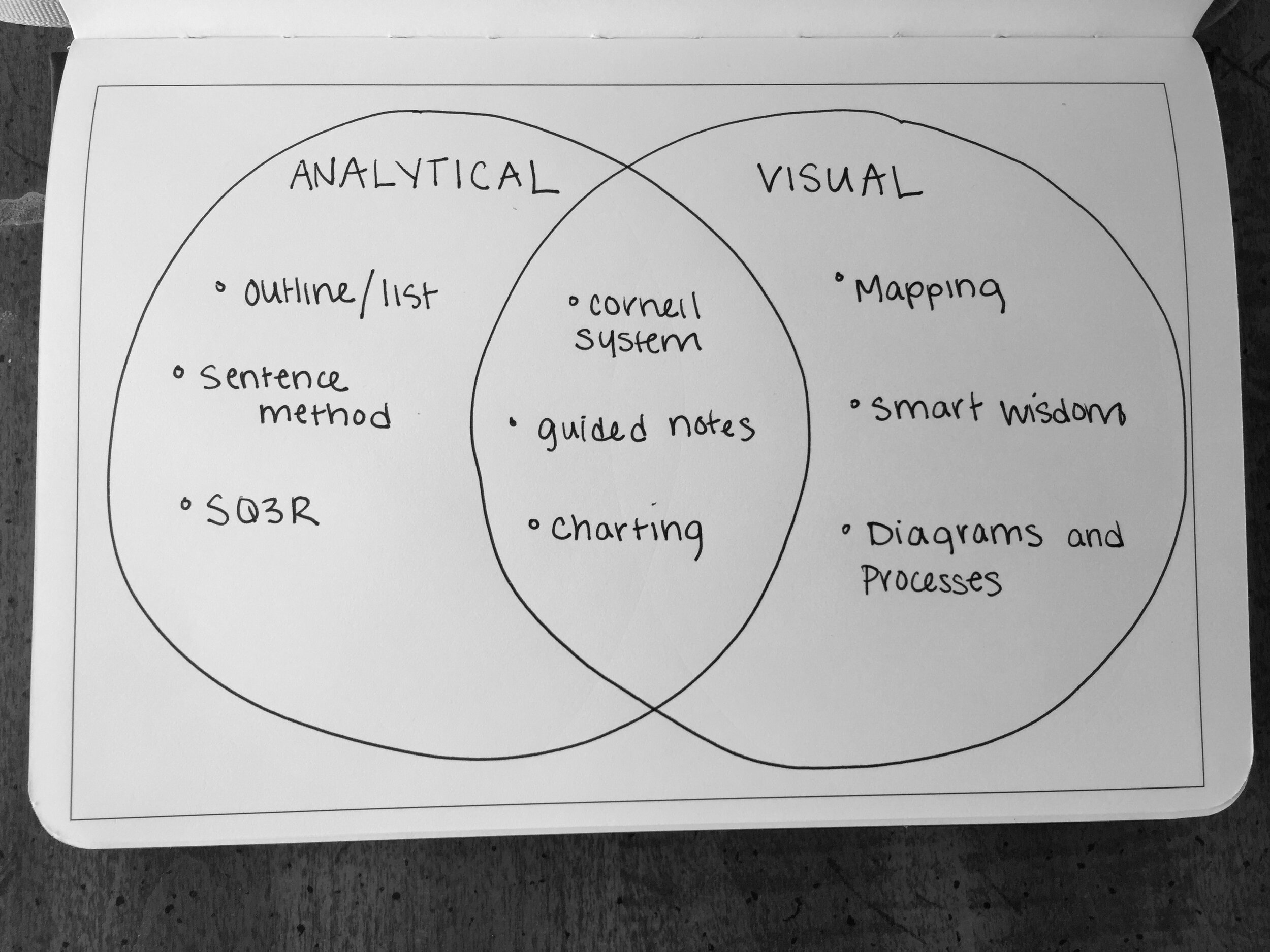
[notes from this post]
Venn diagram– The Venn diagram is best used to compare and contrast notes. Venn diagrams usually comprise overlapping circle that represent sets. A set includes items that all share a specific characteristic. For instance, Set A could include all organisms that live in the water while Set B could include all mammals. In Set A, you would list fish, sharks, plankton, etc. In Set B, you would list humans, elephants, tigers, etc. At the intersection where the two sets overlap, you would list items that fulfill the schematics of both sets (i.e., mammals that live in the water like whales and dolphins). Although there is no limit to the number of sets you compare, complicated Venn diagrams can be difficult to interpret.

[notes from conceptdraw.com]
Fishbone diagram – A Fishbone diagram notes cause and effect and is useful for identifying the root of a problem. Called the Fishbone diagram because the basic shape resembles a fish skeleton. Start by identifying the main problem (effect) and write this in a box center left of the page. Draw a thick horizontal arrow pointing to this box. Think of this as the head and spine of the fish. Brainstorm categories of causes that could lead to this effect. Possible examples could include: methods, equipment, people, materials, measurement, environment. For each of these causes, draw a line branching off of the main arrow. Ask yourself, "Why does this happen?" As you start to brainstorm responses, draw sub-causes branching from the causes. By sorting ideas in such a way, this diagram can help you uncover bottlenecks in your process. This is a note-taking strategy particularly useful in the marketing, manufacturing or service industry for product design and quality defect prevention.
Go digital:
Digital pens are a good choice if you frequently draw diagrams in your notes. Among the top rated are: the LiveScribe 3 Smartpen and the Neo Smartpen N2. The technology in these pens allows you to take notes normally while digitizing your pen strokes so you can view, edit and archive your notes on a laptop tablet or smartphone without having to scan anything. I personally haven't tried either of them, so if you have an opinion or endorsement - please leave it in the comments.
Some smartpens also have an audio recording feature that allows you to replay what was said at a meeting or lecture simply by tapping the corresponding section of written notes.
The downside to these fancy pens is the price. Expect to pay upwards of $100 for a good quality smartpen. Then, there is the cost of ink refills and special paper. However, if you see this technology as a way to revolutionize your productivity, it's worth a second look.
A LITTLE BIT OF BOTH
Cornell
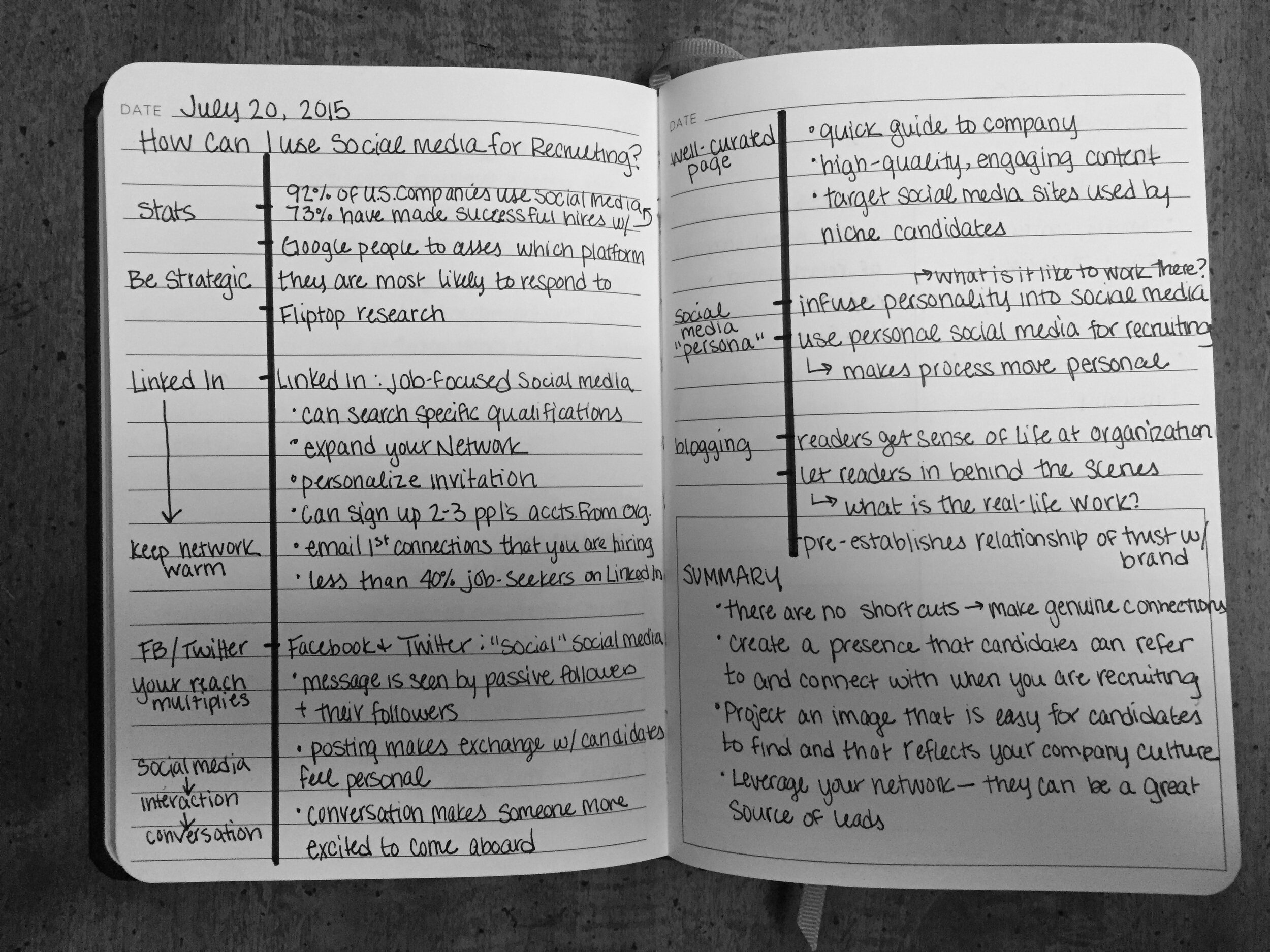
[notes from my Tech Hiring Guide]
An oldie, but a goodie. The Cornell system was developed by—you guessed it—a professor at Cornell University targeted toward students digesting large amounts of material on a daily basis. This system condenses notes by organizing them into different sections on the page.
To use the Cornell system, rule a 2 ½ inch margin on the left side of your paper, leaving a 6 inch section on the right. In the right side of the paper, write down important information. This is the note-taking section. You might consider using the Outline system or the Sentence Method to record these details. But as you go, jot down themes and big-picture ideas that emerge from your notes in the left column. This is the cue column, and the big bullet notes in this section are your “cues.” Ideally, you should have a cue for each important bit of information in your note-taking section.
If it makes sense to do so, use the last few lines at the bottom of the page to summarize your notes. This can be especially useful if you plan on sorting through pages of notes later.
The major bonus of this system is that you only need to take notes once. The divided sections keep your notes organized while you write, so you don’t have to spend time rewriting them later.
This organization also offers an easy way to review. Just fold-over or cover the note-taking section, so you can only see the cue column. Use your cues as tools to help you recall the detailed information in the note-taking section.
When to use:
- Works best for lectures
- Use when trying to synthesize big picture ideas with more detailed information
- Is sometimes used to record meetings
Make it your own:
It is rumored that Bill Gates developed his personal note-taking method based on the Cornell system. As one colleague recalls, he divides his page into four quadrants to record different kinds of information.
This “Split-Page” Method is a great way to hack the Cornell system for use in non-academic settings. Instead of taking notes from top to bottom, reserve sections of your paper for specific types of notes like important dates, goals, action items and questions. This way of organizing your notes makes it easy to stay engaged in a meeting or lecture, especially if you are expected to provide feedback at the end.
Go digital:
Google offers a free Cornell system template or you can create your own in Word.
Guided Notes
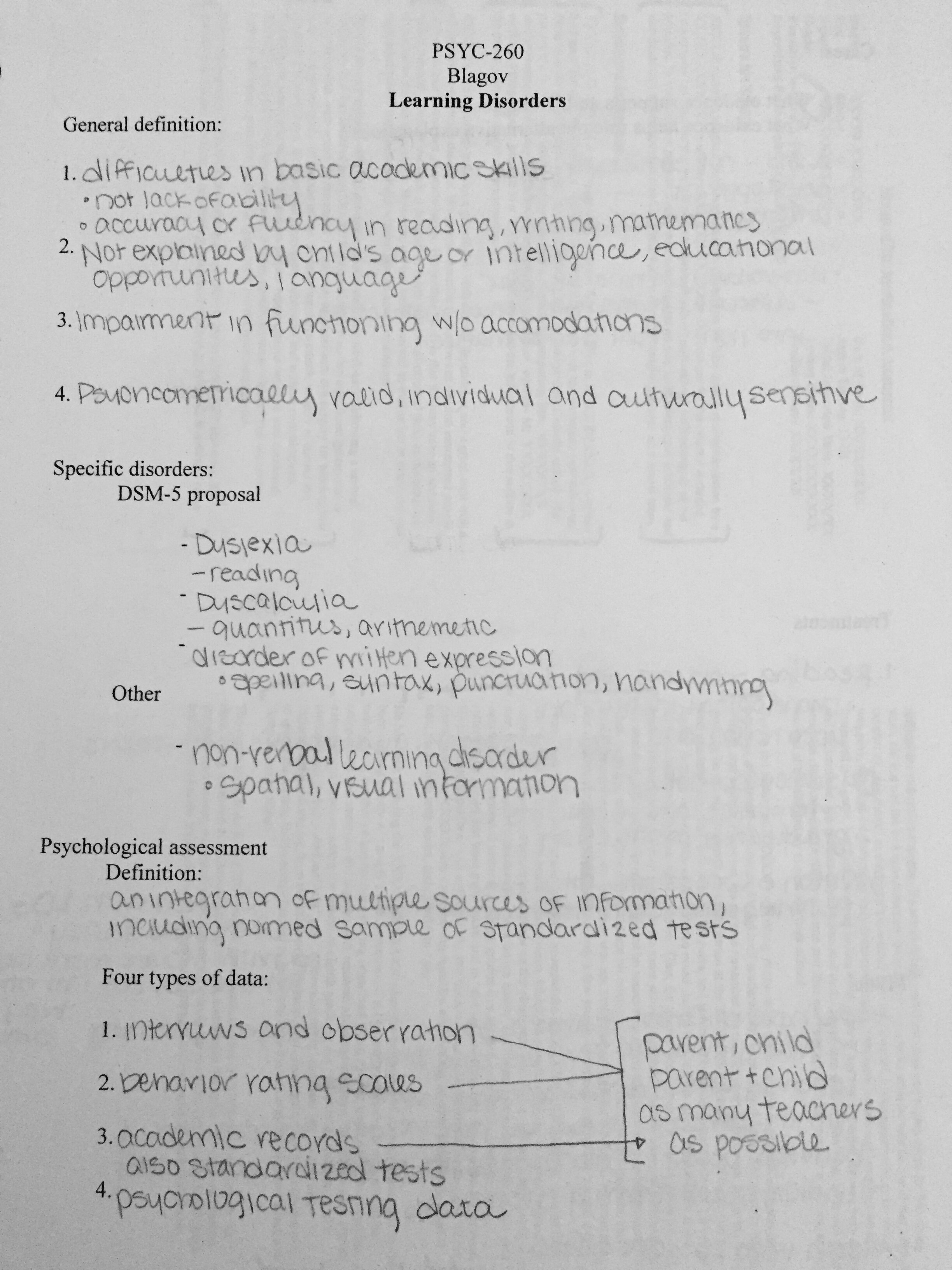
[notes from a psychology class in college]
Guided notes are usually only seen in classrooms, but the same note-taking strategy can be applied to meeting agendas or presentation printouts. Essentially, you can use whatever material is provided out as a “map” to guide your note-taking.
Traditional Guided Notes written by a teacher often look like the skeleton of a lecture where much of the meat or content is missing (and when I taught my management essentials workshop that was exactly what I did with my slides!). With key pieces of information omitted, you are motivated to actively listen or search for those missing details.
This strategy highlights the most important points, and studies show that’s it’s one of the best methods for improving basic recall. It also improves participation because you have less information to write down.
Although Guided Note-taking can be applied in non-classroom settings, its usefulness is limited to scenarios in which a handout is provided. Other note-taking systems work better for exploratory research, brainstorming or unstructured lectures.
When to use:
- Works well for recording key points
- Use when a handout is provided
- Can be applied to agendas and presentations slides (if you are the presenter it is a great way to keep your audience engaged)
Make it your own:
Frequently, lecturers will print out copies of their presentation slides. Add your own notes to these slide handouts to cut down on the amount of writing you have to do and to give the slides more depth. I call this the “writing on the slide” method of note-taking (clever, yes?), and it could be the easiest way for you to capture the most information.
A good presenter won’t simply read off the slides, try to capture relevant information he or she says. This could be a specific example that illustrates the main idea of the presentation, or it could be data-driven information that supports the presenter’s claim. Alternatively, write down your own thoughts and critiques about the information being presented. Annotated information will stand out the next time you review the handout and can help jog your memory of the content.
Go digital:
The obvious answer here is to ask the lecturer to send you digital copies of his or her handout. If it's in a PDF format, you can probably add notes and highlights directly to the electronic file through Adobe Reader. Another option is to use an app like Note Taker HD, which allows you to add hand-written notes to an electronic file on your iPad using your finger or a stylus. While this is a free download, it is only available on iOS systems.
Charting
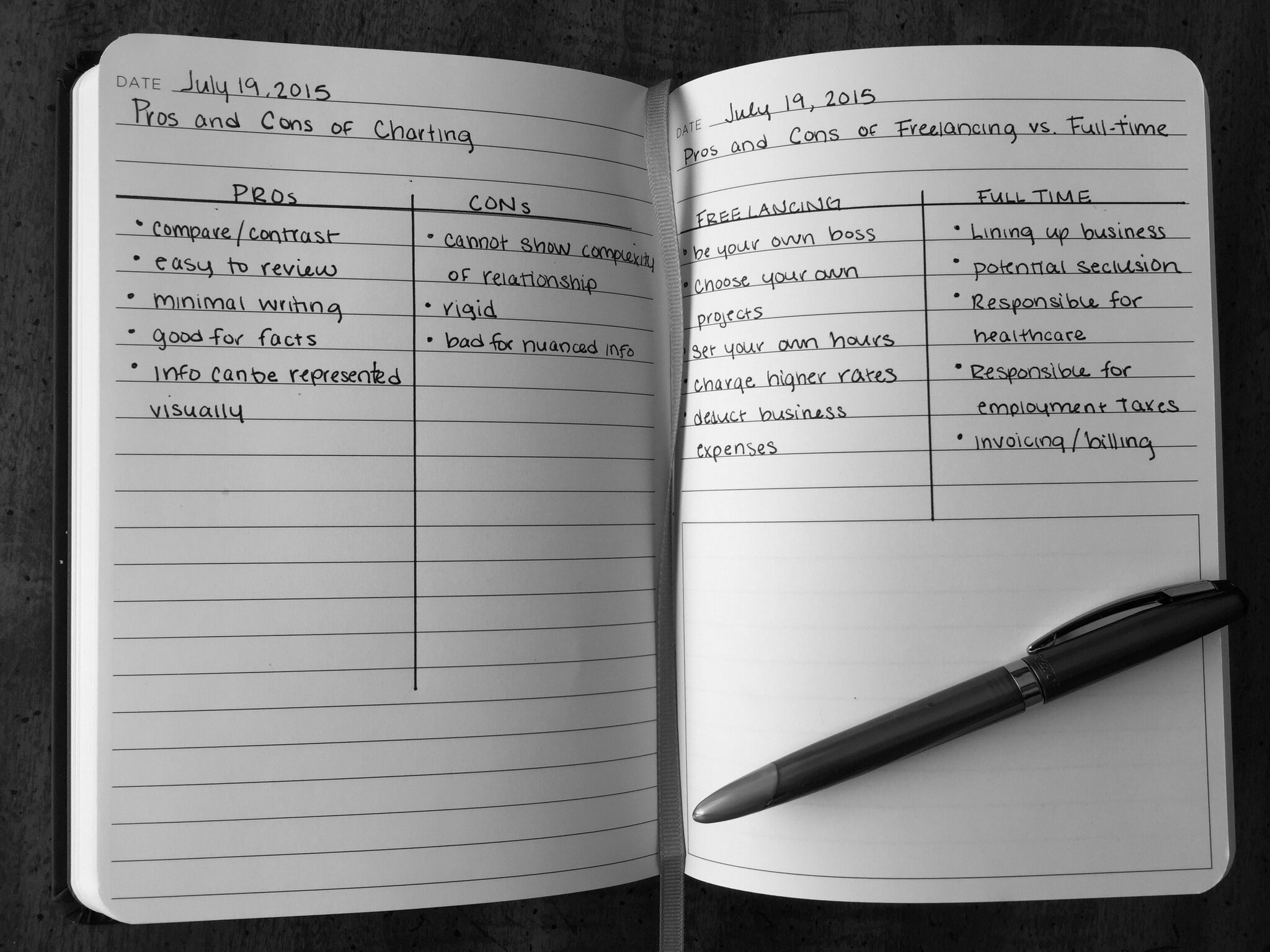
[notes from anthonysdesk.com]
Charting is a great note-taking strategies when you need to compare and contrast ideas. The most widely used charting method is the Pro/Con list. For instance, you are weighing the positive and negative impact of an important decision. Typically you would divide the paper in half. On one side, you list all the positive impacts, and on the other side you list all the negative impacts. Seeing all the information at once can help you make an informed decision.
But the Charting method is not limited to a Pro/Con list. You can chart anything that can be broken down into categories. Other examples include Similarities/Differences, Cost/Benefit or Date/Event/Impact. Once you’ve identified these categories, make a table using the categories as column headers. Record information into the appropriate category as it comes up.
This method works well when you want to look at how one or more ideas relate to one another. It can also minimize the amount of writing you have to do by breaking information down to only relevant pieces. However, it is not always useful for sorting through complex or nuanced information that doesn’t fall neatly into any one category.
When to use:
- Works well with large quantities of factual information
- Use to compare/contrast ideas
- Is easy to review
Make it your own:
When you start charting notes more complicated than a pro/con list, it can be useful to also represent this information visually. Maps, graphs and tables are usually easy to create from charts, and these tools can be useful for making your notes more compelling or memorable.
Go digital:
Digital is definitely the way to go when charting. This is particularly true if you are working with a lot of information. Microsoft Excel and Google Spreadsheets are great charting tools. Both programs allow users to sort data based on any field, add rules for formatting data and visualize data as a graph.
Do you have a note taking strategy not in the list? If so, be sure to leave a comment below. I am always looking for new ways to super charge my note taking.
Just writing and presenting this post made me think a bit more about how I am taking notes and I am going to start experimenting with some new systems.